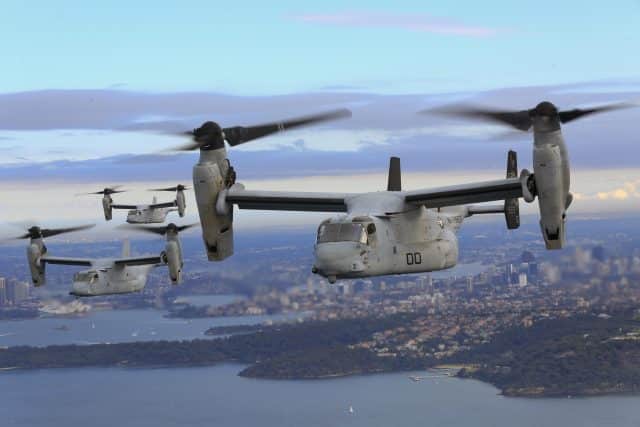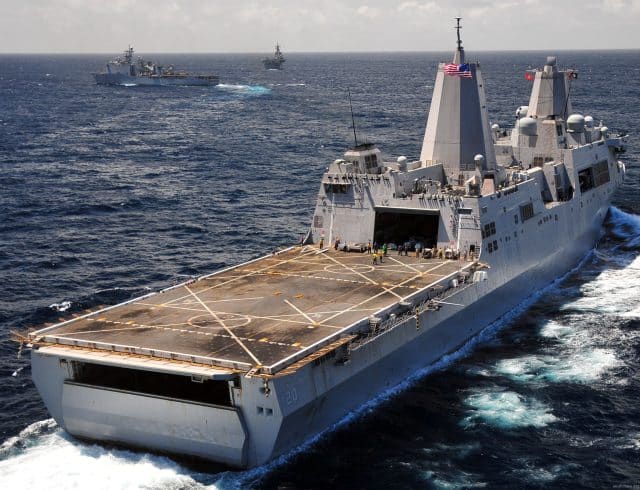MV-22B Osprey crash onto side of USS Green Bay
On the 5th of August 2017, an MV-22B Osprey crashed while on a routine training mission off the coast of Rockhampton in Queensland, Australia. The crash resulted in three deaths, 23 injured and the total loss of the aircraft.
The US Marines were part of a greater simulation, including an embassy reinforcement mission. The crew of the MV-22B Osprey launched from USS Bonhomme Richard, an amphibious assault ship, to the shore of Raspberry Creek to deliver embassy reinforcement personnel. They returned to Bonhomme Richard to refuel and then delivered cargo and a passenger to USS Ashland. Back at Bonhomme Richard, they took part in a mass casualty drill and made two more runs between Raspberry Creek and Bonhomme Richard. The final flight to Raspberry Creek was simulating the non-combatant evacuation operation, extracting the personnel (Marines and Sailors of BLT 3/5) from the embassy and flying them to safety aboard the USS Green Bay which was waiting off of the coast.
The investigation described this as a complex and challenging mission.

The V-22 Osprey is an American tiltrotor military aircraft with VTOL and STOL capabilities designed by a cooperation between Bell Helicopter and Boeing. The Osprey units have been the centre of some controversy because of the cost of development and production. In addition, the V-22 requires more maintenance and has lower availability than traditional helicopters but traditionally has had a lower incident rate. This particular aircraft, bureau number 16834, was current and compliant with all relevant technical directives but, with just 203 flight hours, had not yet reached sufficient flight time for a major inspection.
The Marines manning the MV-22B Osprey were fully trained and qualified and were confirmed as medically fit and having had eight hours or more rest before the mission.
USS Green Bay is a San Antonio-class amphibious transport dock. The flight deck, known as Lambeau Field after the Green Bay Packers’ football stadium, has six landing spots for aircraft. At the time of the incident, five aircraft were parked on the flight deck.

As the MV-22B Osprey approached Green Bay’s flight deck, the aircraft suddenly dropped, descending at a rate of 200-300 foot per minute.
The pilot at the controls, who survived the crash with a broken hip and a broken leg, describes what happened as they approached Spot 5, the most starboard side aft landing spot.
It feels like there is a drop, like a sink. The nose kind of felt like it dipped a touch because it felt like my visibility kind of improved a little bit. Maybe just a little bit of the nose began to fall.
…I think [redacted pilot] said, “Power. Power.” I think [other redacted pilot] said, “Power.” I think I said “Power,” as well.…We pushed it forward and we got no response. So basically at this point it just kind of kept sinking…. It didn’t feel excessive. It just felt like there was nothing you could do.
…At that point, we didn’t feel like we had enough power to continue. I don’t recall seeing anything with the gauges at this point. I just remember being very frightened.
…I feel like I kind of froze a little bit as well just because of what was happening. We hit. We were hitting the side of the ship.
…Because I was just thinking – it was kind of a quick flash of thinking back to the NEW ORLEANS where they had landed on the back, but I think they were able to put enough [of] the plane on the ship where you know they could keep it there and keep it safe where people could get out. That kind of flashed through my mind real quick, but it was like we are nowhere near that. We don’t have hardly any of the plane on the deck of the ship and just remember kind of moving to the right. The plane moving to the right, moving to the right.
He references another similar incident: in December 2015, an MV-22B Osprey descended in the same way as it approached the flight deck of USS New Orleans and the flight crew could not slow the rate of descent. The Osprey unit ended up clinging to the ship’s edge while the passengers and the crew evacuated.
This time, the flight crew was unable to avoid the crash. The pilot at the controls recognised the sudden rate of descent by adding power but a TCL OVERTRAVEL warning illuminated, which showed that all available aircraft power had been applied and the thrust control lever had been pushed into the overtravel region.
There simply was not enough thrust to hold in the hover. In both cases, the issue was deemed to be the recirculated downwash reflecting off the ship’s hull.
The left outer engine casing struck the flight deck. The aircraft travelled right, as the pilot remembered, then smashed into a steel stairway which crushed the cockpit, severely injuring the pilot. At the same time, the left proropter blades impacted the flight deck and another helicopter. The MV-22B Osprey fell into the ocean. Water rushed into the hole in the cockpit and the aircraft swiftly sank.
This video was sent to me by Mike; it was published on YouTube by What You Haven’t Seen earlier this month. Marine officials were unwilling to confirm the video, which shows an MV-22 Osprey crash as taken by two mobile phones on the deck, but said that the video was “consistent with the command investigation.”
The video shows the Osprey unit approaching when it suddenly dips, striking the deck and crashing into the ocean. The video repeats the sequence and shows another angle, followed by the recovery of the wreckage. It ends with photographs from other MV-22 Osprey mishaps.
The report found that the injuries and the deaths occurred “in the line of duty and not due to their misconduct”, absolving the crew and maintenance teams, saying that the crash was caused by potential downwash and insufficient power.
However, a number of other shortcomings were found as a part of the investigation, which did not cause the crash but may have affected the aftermath. Eight of the twenty-one passengers did not use their seatbelts. As the MV-22B Osprey crashed into the ocean, these passengers and unsecured gear flew forwards, injuring passengers in the front of the cabin.
The report also shows some evidence that the Osprey may have been overweight. The passengers carried personal weapons, riot shields, pelican cases and a day’s worth of supplies, estimated at 300 pounds per person, and the Osprey had refuelled, carrying about 8,200 pounds of fuel at the time of the crash. The issue here is that the preflight computation is unreliable: there was some confusion about how many passengers and even how many crew were on board.
In addition, the Assault Force Commander responsible for the lift did not brief the passengers on “emergency egress”, that is, they had not been told how to evacuate in an emergency. Worse, the commander had not been trained on how to provide an egress brief for the aircraft.
The briefing should have been in addition to emergency egress training. Seven of the 21 passengers had no training on evacuating the helicopter in case of emergency. Of those who had attended emergency egress training, two had failed the training.
Two of the three fatalities drowned in the cabin after the aircraft sunk: they never activated their air bottles.
You can read the full report (with redactions) as a scanned PDF. Although the recommendations from the military investigation were redacted, Navy engineers have since reviewed the effect of the downwash for the Osprey units on final approach, specifically looking at how much power is required to combat the downwash effect. In addition, the maximum weight of an Osprey on approach to a ship at sea has been adjusted to ensure that the flight crew has enough power to land safely.








V-22s seem particularly vulnerable to vortex ring states (this may be what you mean by “downwash”): while the aircraft is descending with insufficient forward air speed, the air through the rotor discs forms a stable circulating double torus, which provides little lift and moves down with the aircraft. Increasing power doesn’t help unless you have a lot of power available; the solution is to increase forward speed to reach clean air. This incident looks like a classic example of that failure mode.
The Wikipedia article on the V-22 shows disagreement as to whether it’s more or less susceptible to VRS than pure helicopters; the article on VRS describes it as a known hazard that the pilot(s) should watch for and be prepared to correct for; given this and uncertainty about gross weight, I’m a bit surprised that no fault in the crew was found (at least as far as I can dig through the boilerplate of the first several pages). Possibly there’s an issue with training (aside from the crew not having been taught how to teach passengers about emergency egress)?
The fact that the ship crew were able to get out everyone who found their emergency air bottles, before those bottles ran out, speaks well for that crew.
This article about Military flight safety showed up in my email an hour after your report.
“Aviation Crashes Are Again on the Rise. Are Ongoing Safety and Training Issues to Blame?”
https://www.military.com/daily-news/2022/07/23/aviation-crashes-are-again-rise-are-ongoing-safety-and-training-issues-blame.html
I am not an expert on helicopters; the earlier comments all make perfect sense to me.
There is a video, I believe on Youtube, showing a light aircraft crash. It got caught in the vortex of a passing large helicopter which turned the aircraft upside down at a very low altitude.
Rotor vortex was probably not a factor here. I tend to agree with Roger.
Add to this that the aircraft got below the level of the flight deck, which to me may have meant interference or obstruction of the normal airflow and the air trapped between the rotors and the ship’s hull.
Was the aircraft over its weight limit? Hover would have been affected. The only thing that could have helped in that case would have been increasing airspeed, but they simply did not have room nor altitude for that.
This was a horribly complex situation. The Osprey was fully loaded…perhaps overloaded…given refueled weight plus number of crew/passengers and extra gear. Disc loading was therefore at the max. As has been pointed out, down-wash reflection from the deck creates turbulence that weakens lift in the rotorprop blades, and unlike typical helo blades with 8 degrees twist, Osprey blades have 47+ degrees twist that during heavily loaded descent backwards through their own down-wash are therefore aerodynamically subject to blade stall MUCH earlier than helo blades, especially when descending through turbulent air that quickly disrupts laminar flow over the blades…and destroys lift.
Add in that while approach to the deck looked good–straight on so that both engines would pass over the edge at the same time–, once the blades began to lose lift slightly in the reflected down-wash, the aircraft seemed to twist very slightly to the side…putting the port engine more over the deck and the starboard engine more over the side. Port engine blades were then was biting into more turbulent reflected air and achieving less lift than the starboard engines blades still operating in non-turbulent air over the side. More lift on the right and less on the left caused the roll that had the port engine strike the deck..;.and that was it.
ANY Osprey landing on the SIDE of a deck is, even under normal conditions, a VERY tricky operation.